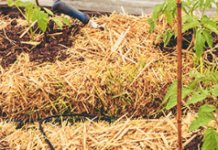The most common fungicide used in fruit tree sprays is captan. Unfortunately, this product is subject to alkaline hydrolysis. This is a process whereby certain pesticides will break down when mixed with high pH water. So let’s say you mix up your spray mixture by captan to 5 gallons of water. If that water has a pH of 7, the captan will break down so that only half of it will still be present in 8 hours. However, if the water you use has a pH of 10, half the captan will break down in 2 minutes.
Malathion used to be the most common insecticide used for fruit pest control by gardeners but is becoming more difficult to find. It isn’t nearly as sensitive to alkaline hydrolysis as captan but still will break down under high pH conditions. Fortunately, it is stable at a pH between 5 and 7. Lambda-cyhalothrin, found in Bonide Fruit Tree & Plant Guard, is a relatively new product for fruit pest control that also is stable between a pH of 5 to 7.
Note that alkaline hydrolysis does not affect all pesticides. Captan is the exception, not the rule. For a listing of common pesticides and their susceptibility to alkaline hydrolysis, see http://ecommons.library.cornell.edu/bitstream/1813/5149/1/FLS-118.pdf
So, how do you bring down the pH of your spray water if it is high? Commercial people use buffering agents but that may be difficult for homeowners to find. Food grade citric acid can help. If you have a pH of 8.0, add 2 ounces of this citric acid per 100 gallons of water (1 and 1/4 teaspoons per 10 gallons) to bring the pH down to about 5.5. (Ward Upham)




